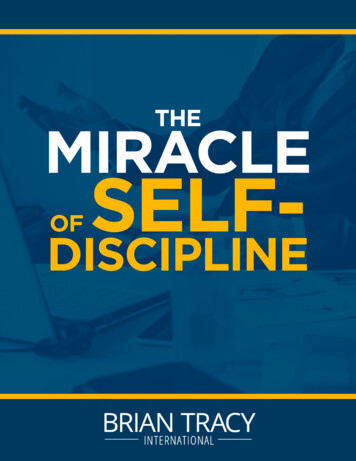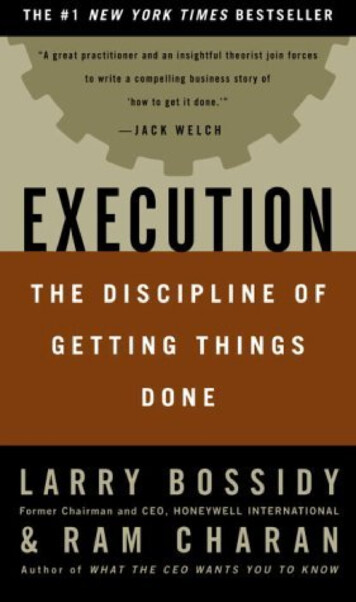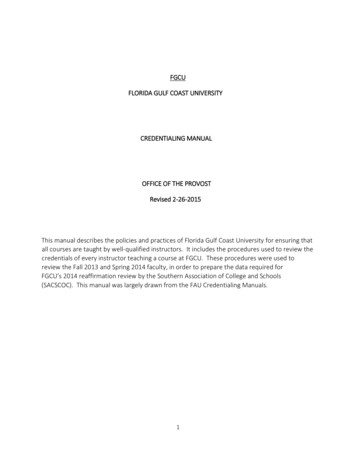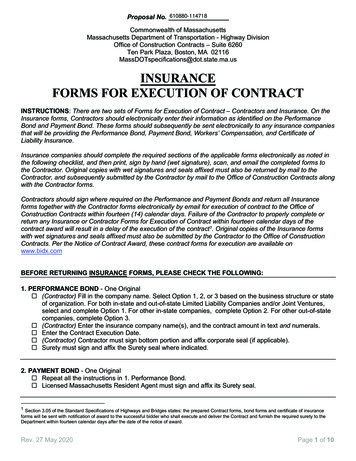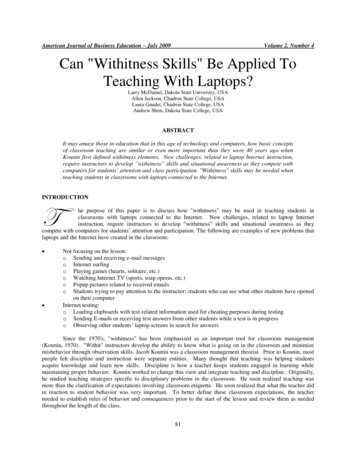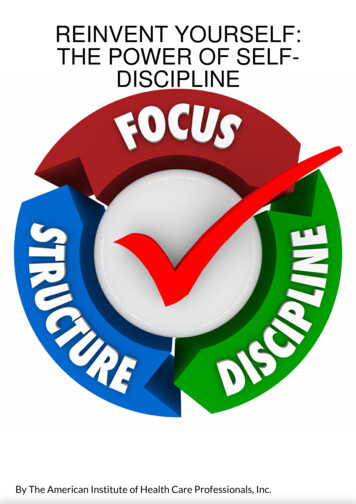
Transcription
The following is a highlighted summary of the book, Execution, published by Crown Business.The statements below are key points of the book as determined by James Altfeld and have beenmade available at no charge to the user.Execution:The Discipline of Getting Things DoneByLarry Bossidy & Ram CharanIntroductionToo many leaders fool themselves into thinking their companies are well run. They’relike the parents in Garrison Keillor’s fictional Lake Wobegon, all of whom think theirchildren are above average. Then the top performers at Lake Wobegon High Schoolarrive at the University of Minnesota or Colgate or Princeton and find out they’re averageor even below average. Similarly, when corporate leaders start understanding how theGE’s and Emerson Electrics of this world are run—how superbly they get thingsdone—they discover how far they have to go before they become world class inexecution.Here is the fundamental problem: People think of execution as the tactical side ofbusiness, something leaders delegate while thy focus on the perceived “bigger” issues.This idea is completely wrong. Execution is not just tactics—it is a discipline and asystem. It has to be built into a company’s strategy, its goals, and its culture. And theleader of the organization must be deeply engaged in it. He can delegate its substance.We talk to many leaders who fall victim to the gap between promises they’ve made andresults their organizations delivered. They frequently tell us they have a problem withaccountability—people aren’t doing the things they’re supposed to do to implement aplan. They desperately want to make changes of some kind, but what do they need tochange? They don’t know.Execution is a specific set of behaviors and techniques that companies need to master inorder to have competitive advantage.The Gap Nobody KnowsWhen companies fail to deliver on their promises, the most frequent explanation is thatthe CEO’s strategy was wrong. But the strategy by itself is not often the cause.Strategies most often fail because they aren’t executed well. Things that are supposed to
happen don’t happen. Either the organizations aren’t capable of making them happen, orthe leaders of the business misjudge the challenges their companies face in the businessenvironment, or both.Build-to-order improves inventory turnover, which increases asset velocity, one of themost under-appreciated components of making money. Velocity is the ratio of salesdollars to net assets deployed in the business, which in the most common definitionincludes plant and equipment, inventories, and accounts receivable minus accountspayable. Higher velocity improves productivity and reduces working capital. It alsoimproves cash flow, the life blood of any business, and can help improve margins as wellas revenue and market share.Dell turns its inventory over eighty times a year, compared with about ten to twenty timesfor its rivals, and its working capital is negative. As a result, it generates an enormousamount of cash. In the fourth quarter of fiscal 1001, with revenues of 8.1 billion and anoperating margin of 7.4 percent, Dell had cash flow of 1 billion from operations. Itsreturn on invested capital for fiscal 2001 was 355 percent—an incredible rate for acompany with its sales volume. Its high velocity also allows it to give customers thelatest technological improvements ahead of other makers, and to take advantage of fallingcomponent costs—either to improve margins or to cut prices.The gap between promises and results is widespread and clear. The gap nobody knows isthe gap between what a company’s leaders want to achieve and the ability of theirorganization to achieve it.Everybody talks about change. In recent years, a small industry of change-meisters haspreached revolution, reinvention, quantum change, breakthrough thinking, audaciousgoals, learning organizations, and the like. We’re not necessarily debunking this stuff.But unless you translate big thoughts into concrete steps for action, they’re pointless.Without execution, the breakthrough thinking breaks down, learning adds no value,people don’t meet their stretch goals, and the revolution stops dead in its tracks. Whatyou get is change for the worse, because failure drains the energy from your organization.Repeated failure destroys it.No company can deliver on its commitments or adapt well to change unless all leaderspractice the discipline of execution at all levels. Execution has to be a part of acompany’s strategy and its goals.If you don’t know how to execute, the whole of your effort as a leader will always be lessthan the sum of its parts.Execution Comes of AgeAfter Compaq’s board fired Pfeiffer, chairman and founder Ben Rosen took pains to saythat the company’s strategy was fine. The change, he said, would be “in execution Ourplans are to speed up decision-making and make the company more efficient.”
To understand execution, you have to keep three key points in mind:1. Execution is a discipline, and integral to strategy.2. Execution is the major job of the business leader.3. Execution must be a core element of an organization’s culture.Execution is a DisciplineNo worthwhile strategy can be planned without taking into account the organization’sability to execute it. execution is a systematic way of exposing reality and acting on it.Much has been written about Jack Welch’s style of management—especially histoughness and bluntness, which we would argue that the core of his management legacyprocesses, making it a model of an execution culture.The heart of execution lies in the three core processes: the people process, the strategyprocess, and the operations process.Execution is the Job of the Business LeaderLots of business leaders like to think that the top dog is exempt from the details ofactually running things. It’s a pleasant way to view leadership: you stand on themountaintop, thinking strategically and attempting to inspire your people with visions,while managers do the grunt work.An organization can execute only if the leader’s heart and soul are immersed in thecompany.The leader must be in charge of getting things done by running the three coreprocesses—picking other leaders, setting the strategic direction, and conductingoperations.How good would a sports team be if the coach spent all his time in his office makingdeals for new players, while delegating actual coaching to an assistant?Only a leader can ask the touch questions that everyone needs to answer, then manage theprocess of debating the information and making the right trade-offs. And only the leaderwho’s intimately engaged in the business can know enough to have the comprehensiveview and ask the touch incisive questions.Dialogue is the core of culture and the basic unit of work. How people talk to each otherabsolutely determines how well the organization will function. everyone likes to say that people are the most important ingredient in their success.But they often hand off the job of assessing people and rewarding them to the HR staff,then rubber-stamp the recommendations at their reviews.
Only line leaders who know the people can make the right judgments. Good judgmentscome from practice and experience.But there’s an enormous difference between leading an organization and presiding overit. The leader who boasts of her hands-off style or puts her faith in empowerment is notdealing with the issues of the day. She is not confronting the people responsible for poorperformance, or searching for problems to solve and then making sure they get solved.She is presiding, and she’s only doing half her job.Leading for execution is not about micromanaging or being “hands-on,” or disempowering people. Rater, it’s about active involvement—doing the things leadersshould be doing in the first place.The leader who executes assembles an architecture of execution. He puts in place aculture and processes for executing, promoting people who get things done more quicklyand giving them greater rewards.Jack Welch, Sam Walton, and Herb Kelleher Leaders of this ilk are powerful andinfluential presences because they are their businesses. They are intimately and intenselyinvolved with their people and operations. They connect because they know the realitiesand talk about them. They’re knowledgeable about the details. They’re excited aboutwhat they’re doing. They’re passionate about getting results. This is not “inspiration”through exhortation or speechmaking. These leaders energize everyone by the examplethey set.Execution Has to Be in the CultureLeaders who execute look for deviations from desired managerial tolerances—the gapbetween the desired and actual outcome in everything from profit margins to the selectionof people for promotion. Then they move to close the gap and raise the bar still higheracross the whole organization.Why People Don’t Get ItThe intellectual challenge of execution is in getting to the heart of an issue throughpersistent and constructive probing. Let’s say a manager in the X division plans an 8percent sales increase in the coming year, even though the market is flat. In their budgetreviews, most leaders would accept the number without debate or discussion. But in anexecution company’s operating review, the leader will want to know if the goal isrealistic. “fine,” she’ll ask the manager, “but where will the increase come from? Whatproducts will generate the growth? Who will buy them and what pitch are we going todevelop for those customers? What will our competitor’s reaction be? What will ourmilestones be?” If a milestone hasn’t been reached at the end of the first quarter, it’s ayellow light: something’s not going as planned, and something will need to be changed.“are the right people in charge of getting it done,” “and is their accountability clear?Whose collaboration will be required, and how will they be motivated to collaborate?Will the reward system motivate them to a common objective?” In other words, the
leader doesn’t just sign off on a plan. She wants an explanation, and she will drill downuntil the answers are clear.Organizations don’t execute unless the right people, individually and collectively, focuson the right details as the right time.The Trouble with JoeJoe, the CEO whose downfall we described in chapter 1, is a typical leader who didn’tknow how to execute.How would Joe have behaved differently if he had had the know-how of execution? Firs,he would have involved all the people responsible for the strategic plan’s outcome.They would have set goals based on the organization’s capability for delivering results.Organizational capability includes having the right people in the right jobs.Second, Joe would also have asked his people about the how’s of execution: how,specifically, were they going to achieve their projected demand on a timely basis, theirinventory turns, and cost and quality goals? Anybody who didn’t have the answerswould have to get them before the plan was launched.Third, Joe would have set milestones for the progress of the plan, with strictaccountability for the people in charge.The Building Blocks of ExecutionWhat exactly does a leader who’s in charge of execution do? How does he keep frombeing a micromanager, caught up in the details of running the business? Know your people and your business.Insist of realism.Set clear goals and priorities.Follow through.Reward the doers.Expand people’s capabilities.Know yourself.Know Your People and Your BusinessLeaders have to live their businesses.RAM:Leaders who are connected have distilled the challenges facing the business unit they arevisiting into a half dozen or fewer fundamental issues. These challenges do not changemuch over short periods of time, and the way leaders like Larry master the total companyis through a short list that cut across multiple business units.
Being present allows you, as a leader, to connect personally with your people, andpersonal connections help you build your intuitive feel for the business as well as for thepeople running the business. They also help to personalize the mission you’re askingpeople to performLarry: As a leader, you have to show up. You’ve got to conduct business reviews. Youcan’t be detached and removed and absent. When you go to an operation and you run areview of the business, the people may not like what you tell them, but they will say, “atleast he cares enough about my business to come and review it with us today. He stayedthere for four hours. He quizzed the hell out of us.” Good people want that. It’s a way ofraising their dignity.It’s also a way to foster honest dialogue, the kind that can sometimes leave people feelingbruised if they take it personally.At Honeywell, after I do a business review, I write the leader a formal letter summarizingthe things he agreed to do. But then I also write a personal note the leader and say,“Gary, nice job yesterday. Productivity is not up to standards, and you need to work onit. Otherwise things are going great.” It’s just a note, takes five minutes.If a manager is having trouble, you don’t want to threaten to fire him—you want to helphim with his problem.Insist on RealismSometimes the leaders are simply in denial. When we ask leaders to describe theirorganization’s strengths and weaknesses, they generally state the strengths fairly well, butthey’re not so good on identifying the weaknesses. And when we ask what they’re goingto do about the weaknesses, the answer is rarely clear or cohesive.Was it realistic for AT7T to acquire a bunch of cable businesses it didn’t know how torun? The record shows it wasn’t.How do you make realism a priority? You start by being realistic yourself.Set Clear Goals and PrioritiesLeaders who execute focus on a very few clear priorities that everyone can grasp. Whyjust a few? First, anybody who thinks through the logic of a business will see thatfocusing on three or four priorities will produce the best results from the resources athand. Second, people in contemporary organizations need a small number of clearpriorities to execute well.A leader who says “I’ve got ten priorities” doesn’t know what he’s talking about—hedoesn’t know himself what the most important things are. You’ve got to have these few,clearly realistic goals and priorities, which will influence the overall performance of thecompany.
One thing you’ll notice about leaders who execute is that they speak simply and directly.They talk plainly and forthrightly about what’s on their minds. They know how tosimplify things so that others can understand them, evaluate them, and act on them, sothat what they say becomes common sense.Reward the DoersIf you want people to produce specific results, you reward them accordingly. This factseems so obvious that it shouldn’t need saying. Yet many corporations do such a poorjob of linking rewards to performance that there’s little correlation at all. They don’tdistinguish between those who achieve results and those who don’t either in base pay orin bonuses and stock options.Expand People’s Capabilities through CoachingEducation is an important part of expanding people’s capabilities—if it’s handled right.You need to make judgments about which people have the potential to get somethinguseful out of a course and what specific things you’re trying to sue education toaccomplish, in order to expand the capabilities of the organization.We ask people look to at three or four issues facing the company, and we form them intoteams to work on those issues.Keep in mind that 80 percent of learning takes place outside the classroom.Leaders in contemporary organizations may be able to get away with emotional weaknessfor a brief time, but they can’t hide it for long. They face challenges to their emotionalstrength all the time.How can your organization face reality if people don’t speak honestly, and if its leadersdon’t have the confidence to surface and resolve conflicts or give and take honestcriticism? How can a group correct mistakes or get better if its members don’t have theemotional fortitude to admit they don’t have all the answers?Putting the right people in the right jobs requires emotional fortitude. Failure to deal withunderperformers is an extremely common problem in corporations, and it’s usually theresult of the leader’s emotional blockages. Moreover, without emotional fortitude, youwill have a hard time hiring the best people to work for you.A manager who is emotionally weak will avoid such people out of fear that they willundercut his power. His tendency will be to protect his fragile authority.Eventually, such emotional weakness will destroy both the leader and the organization. four core qualities that make up emotional fortitude:Authenticity: you’re real, not a fake. Your outer person is the same as your innerperson
Self-Awareness: Know thyself it’s the core of authenticity.Self-awareness gives you the capacity to learn from your mistakes as well as yoursuccesses. It enables you to keep growing.Self-Mastery: When you know yourself, you can master yourself. You can keep yourego in check, take responsibility for your behavior, adapt to change, embrace new ideas,and adhere to your standards of integrity and honesty under all conditions.Self-mastery is the key to true self-confidence.Self-confident people contribute the most to dialogues.They know they don’t know everything; they are actively curious, and encourage debateto bring up opposite views and set up the social ambience of learning from others. Theycan take risks, and relish hiring people who are smarter than themselves.Humility: the more you can contain your ego, the more realistic you are about yourproblems. you can learn from anyone at any time.Creating the Framework for Cultural ChangeMost efforts at cultural change fail because they are not linked to improving thebusiness’s outcomes. cultural change gets real when your aim is execution.“If we want to change the culture, what should be our next question?”One member of the team asked in response, “How should the culture be changed?” Asecond member said, “make it better.” Then someone asked ”From what to what?” andthe light bulb went on.The CEO divided the team into groups of six and asked each to find ten pairs of “fromwhat to what.” the leader teamThe teams agreed that improving accountability would be the most importantchange. “where does that begin?” the answer was: “With this team.” Then theleader asked, “Are you willing to hold each of us accountable?”The final question was: “After we change our group’s behavior, what do we donext?” The head of HR said, “communicate it to twenty thousand people.”
After we hold ourselves accountable, the next phase is for this team to hold the threehundred managers in this division accountable for their performance, without which threethousand supervisors and seventeen thousand employees will not experience the cultureand discipline of execution.”Operationalizing CultureWe don’t think ourselves into a new way of acting, we act ourselves into a new wayof thinking.New EDB Beliefs We are committed to our clients’ success. Collaboration is the key to our success. We are going to be accountable and committed. We will be better listeners to our clients.Linking Rewards to PerformanceThe foundation of changing behavior is linking rewards to performance and making thelinkages transparent. A business’s culture defines what gets appreciated and respectedand, ultimately, rewarded. It tells the people in the organization what’s valued andrecognized, and in the interest of trying to make their own careers more successful, that’swhere they will concentrate.At EDS, Dick Brown moved quickly to make sure the performers got rewarded morethan the non performers.“There were no negative consequences for poor performance,” recalled oneexecutive. “Not only no consequences, but if you were part of the good old boynetwork, there really wasn’t accountability for negative behavior toward thecompany.” Added another, “It was always somebody else’s problem.” if you’re staying the same, you’re falling behind.The Social Software of ExecutionThe inability to act decisively—which translates into an inability to execute—is rooted inthe corporate culture and seems to employees to be impervious to change.The key word here is “seems,” because, in fact, leaders create a culture of indecisiveness,and leaders can break it.Structure divides an organization into units designed to perform certain jobs.A key component of software is what we call Social Operating mechanisms.GE’s highly developed Social Operating System is central to the company’s success. Itsmain social Operating Mechanisms include the Corporate Executive Council (CEC),
which meets quarterly; Session C, the annual leadership and organizational reviews; S-1and S-2, the strategy and operating reviews; and Boca, an annual meeting in Boca Raton,Florida, where operating managers meet to plan the coming year’s initiatives and relaunch current initiatives.At CEC meetings, which run two and a half days, GE’s roughly thirty-five topleaders review all aspects of their businesses and the external environment, identifythe company’s greatest opportunities and problems, and share best practices. TheCEO also uses the forum to observe how his leaders think and how they worktogether, and to coach them.A Session C meeting is an intense eight-to-ten-hour gathering where the CEO and headof HR meet with the business leaders top HR executives of each business unit. Theyreview the unit’s prospective talent pool and its organizational priorities. Does GE havethe right people in the right jobs to execute its strategies? Who needs to be promoted orrewarded, who needs help with development, who can’t handle the job? picking and evaluating people has become a core competence at GE.The S-1 strategy meeting takes place toward the end of the second quarter. Here theCEO, CFO, and members of the office of the CEO meet with each unit head and his orher team to discuss the strategy for the next three years, including the initiatives agreedupon by the CEC and the fit between the strategy and the people in charge of executing it.The sj-2 meeting, held in November, is the operating plan meeting that focuses more onthe coming twelve to fifteen months, linking strategy to operational priorities andresource allocation.We don’t expect people to know everything, but we do expect people to get the bestanswers they can get, and they get them by working with other people.The Importance of Robust DialogueYou cannot have an execution culture without robust dialogue.Robust dialogue starts when people go in with open minds. They’re not trapped bypreconceptions or armed with a private agenda. They want to hear new information andchoose the best alternatives, so they listen to all sides of the debate and make their owncontributions.When people speak candidly, they express their real opinions, not those that will pleasethe power players or maintain harmony.Formality suppresses dialogue; informality encourages it. Formal conversations andpresentations leave little room for debate. They suggest that everything is scripted andpredetermined. Informal dialogue is open. It invites questions, encouraging spontaneityand critical thinking.
Informality gets the truth out.Finally, robust dialogue ends with closure. At the end of the meeting, people agree aboutwhat each person has to do and when. They’ve committed to it in an open forum; theyare accountable for the outcomes.Think about the meetings you’ve attended—those that were a hopeless waste of time andthose that produced energy and great results. What was the difference? the difference was in the quality of the dialogue.Dialogue alters the psychology of a group. It can either expand a group’s capacity orshrink it. It can be energizing or energy-draining. It can create self-confidence andoptimism, or it can produce pessimism. It can create unity, or it can create bitter factions.Robust dialogue brings out reality, even when that reality makes people uncomfortable,because it has purpose and meaning.Leaders Get the Behavior They Exhibit and Tolerate“the culture of a company is the behavior of its leaders. Leaders get the behavior theyexhibit and tolerate. You change the culture of a company by changing the behavior ofits leaders. You measure the change in culture by measuring the change in the personalbehavior of its leaders and the performance of the business.” when I started, my first thought was always to see how good a person was in a job.After all, that’s what made the business run. As tie went on, I still talked about that, but Ialso kept thinking, What is the growth potential of this person? I began to ask a lot morequestions and get dialogue going on long-range potential.I also got more people involved in the discussion, because when you expand theaudience, you know more.We acknowledged that the person being discussed was going to hear everything that wassaid in that room anyway, and we’d agree that we would be candid but professional.We took care not to say anything about the person that you wouldn’t say to his or herface.The Job No Leader Should Delegate—Having the Right People in the Right PlaceGiven the many things that businesses can’t control, from the uncertain state of theeconomy to the unpredictable actions of competitors, you’d think companies would paycareful attention to the one thing they can control—the quality of their people, especiallythose in the leadership pool. An organization’s human beings are its most reliable
resource for generating excellent results year after year. Their judgments, experiences,and capabilities make the difference between success and failure. we notice, the4se leaders don’t pay enough attention to people because they’re toobusy thinking about how to make their companies bigger or more global than those oftheir competitors. What they’re overlooking is that the quality of their people is the bestcompetitive differentiator. over time, choosing the right people is what creates that elusive status sustainablecompetitive advantage.If you look at any business that’s consistently successful, you’ll find that its leaders focusintensely and relentlessly on people selection.When I retired from Allied Signal in 1999, I considered the greatest sign of our strengthto be the extraordinary quality of our leadership pipeline. One measure of their qualitywas that several of our outstanding people had been recruited to lead other organizations,among them Paul Norris (who became CEO of W.R. Grace); Dan Burnham, hired asRaytheon’s CEO; Gregory L. Summe (CEO of Perkin Elmer); and Frederic M. Poses(CEO of American Standard).One of the first things I did was to visit the company’s plants, meet the managers, and geta feel for their individual capabilities. I didn’t just talk to them; I talked to their people aswell, to see how they perceived their work environment and how they behaved—both ofwhich reflect the kind of job a leader does. It was during those visits that I came to seethat the company’s inattention to leadership development was a major problem.While I was impressed with my half-dozen direct reports, I was less impressed with theheads of our operating units and the teams they had built.At GE 85 percent of the executives are promoted from within—that’s how good thecompany is at developing leaders. And it got so good because Jack Welch—and now hissuccessor, Jeff Immelt—made leadership development a top priority and demanded thatall of his executives do the same.Why the Right People Aren’t in the Right JobsCommon sense tells us the right people have to be in the right jobs. Yet so often theyaren’t. What accounts for the mismatches you see every day? The leaders may not knowenough about the people they’re appointing. They may pick people with whom they’recomfortable, rather than others who have better skills for the job. They may not have thecourage to discriminate between strong and week performers and take the necessaryactions. All of these reflect one absolutely fundamental shortcoming: The leaders aren’tpersonally committed to the people process and deeply engaged in it.
Lack of KnowledgeLeaders often rely on staff appraisals that focus on the wrong criteria. Or they’ll take afuzzy and meaningless recommendations for someone a direct report likes. “bob’s agreat leader,” the candidate’s advocate exclaims. “He’s a great motivator, a greatspeaker. He gets along with people, and he’s smart as hell.” The leader doesn’t askabout the specific qualities that make bob right for the job. Often, in fact, he doesn’t havea good grasp of the job requirements themselves. He hasn’t defined the job in terms of itsthree or four nonnegotiable criteria—things the person must be able to do in order tosucceed.Lack of CourageMost people know someone in their organization who doesn’t perform well, yet managesto keep his job year after year. The usual reason, we find, that the person’s leader doesn’thave the emotional fortitude to confront him and take decisive action.The Psychological Comfort FactorMany jobs are filled with the wrong people because the leaders who promote them arecomfortable with them. It’s natural for executives to develop a sense of loyalty to thosethey’ve worked with over time, particularly if they’ve come to trust their judgments.Bottom Line: Lack of Personal CommitmentWhen the right people are not in the right jobs, the problem is visible and transparent.Leaders know intuitively that they have a problem and will often readily acknowledge it.But an alarming number don’t don anything to fix the problem. You can’t will thisprocess to happen by issuing directives to find the best talent possible. As noted earlier,leaders need to commit as much as 40 percent of their time and emotional energy, in oneform or another, to selecting, appraising, and developing people.But the foundation of a great company is
The Discipline of Getting Things Done By Larry Bossidy & Ram Charan Introduction Too many leaders fool themselves into thinking their companies are well run. They’re like the parents in Garrison Keillor’s fictional Lake Wobegon, all of whom think their children are above average. Then the top performers at Lake Wobegon High SchoolFile Size: 754KBPage Count: 35Explore furtherExecution Excellence: The 5 Key Disciplines - FP Advancefpadvance.comBook Summary: "Execution. The Discipline of Getting Things .www.jfdperfsolutions.comExecution — The Discipline of Getting Things Done .medium.comTHE 7 HABITS OF HIGHLY EFFECTIVE PEOPLEcontent.byui.edu(PDF) OPERATIONAL MANAGEMENT STUDYwww.researchgate.netRecommended to you b
